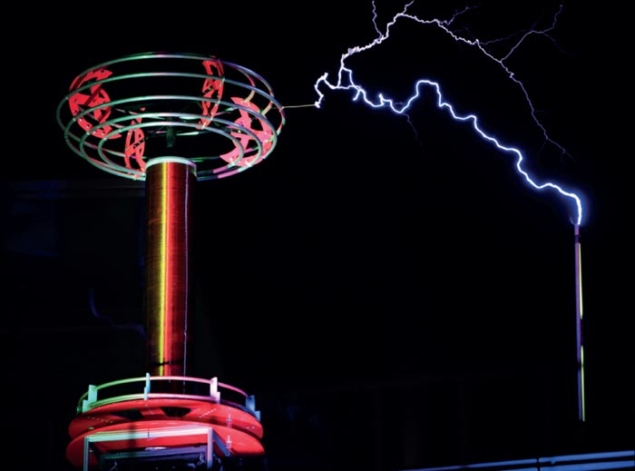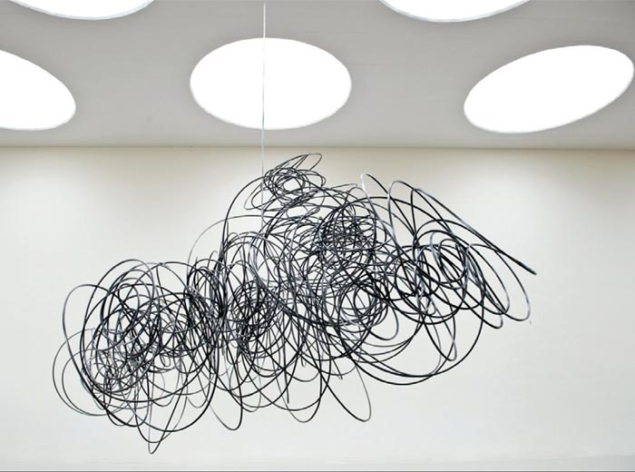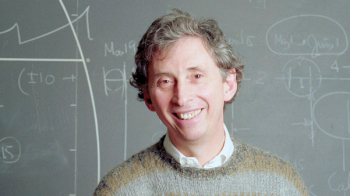What it took to set up the creative collisions of Arts@CERN.

Image credit: A Kolb.
Take a 27-km, record-breaking machine, with 10,000 scientists from 100 countries and 630 institutions, throw in selected artists and arts specialists, and what do you get? An experiment to bring about head-on collisions between things that are even more elusive than the Higgs Boson – creativity, imagination and human ingenuity. Without them, science, art and technology would not exist. The name of this experiment is Arts@CERN, and last year saw the switch-on of this new and rather different collider at CERN.
The start-up has seen CERN collaborate in the world’s most prestigious digital-arts festival, Ars Electronica, in Linz; feature in the keynote event at the Agenda 2016 conference at Moderna Museet, in Stockholm; supply live footage from the LHC to the US film director David Lynch for the Mathematics exhibition at one of the world’s leading contemporary arts museums, Fondation Cartier, in Paris; and have its research into antimatter feature on the centre spread of China’s best-selling design magazine.

Image credit: Rubra.
Other results of the arts switch-on involve specially curated visits to CERN’s facilities for leading international artists. Recently these included the Swiss video artist Pipilotti Rist, the Polish conceptual artist Goshka Mocuga and the master of contemporary dance, the US choreographer William Forsythe, as well as up-and-coming young artists, such as performer Niamh Shaw from Ireland. And to cap it all, this year CERN has two artists in residence on the new, three-year international artists’ residency programme, Collide@CERN, which is funded and supported by external donors and partners.
This all seems a long time since 2009, when I was given the opportunity to go anywhere in the world after I received the Clore Fellowship – an award for cultural leadership. Instead of taking the opportunity to work in a famous arts organization, I decided to approach CERN to come for three months, supported by the UK Government who funded my award, to carry out a feasibility study for an artists’ residency scheme. Little did I know that I would be hired in the spring of 2010 to build a p(art)icle collider for CERN.
Making us human

Courtesy: Ruben van Leer.
So why should CERN engage with the arts? CERN has a mission to engage science in society. The arts reach areas that science and technology alone cannot reach – touching the public who might otherwise be turned off. By joining forces, arts, technology and science make an unbeatable force for change and innovation in the 21st century, as Eric Schmidt, now executive chair of Google, points out. In the words of CERN’s director-general, Rolf Heuer: “They are expressions of what makes us human in the world.”
This phrase, more than any other, shows what is behind CERN’s high-level engagement with the arts and can be summed up in a simple equation: arts + science + technology = culture. For an organization to be truly cultural and innovative in the 21st century, it has to embrace all factors and facets of human experience, engaging with them on the same level of excellence as its institutional values.
Science and the arts are intimately connected in other ways, too. The British sculptor Antony Gormley is one of several leading international artists who are the patrons of the Collide@CERN artist in residence scheme. He recently donated one of his pieces, Feeling Material, to CERN in acknowledgement of the inspiration of particle physics on his work; it now hangs in the Main Building. Gormley is clear about the connection between art and science: “My whole philosophy is that art and science are better together than apart. We have somehow accepted an absolute division between analysis and intuition but I think actually the structures that they both come up with are an intricate mix of the two.”
The showpiece event that signalled the switch-on of CERN’s arts experiment was the six-day Ars Electronica Festival in Linz in 2011. Being the world’s leading digital-arts festival, it features spectacular performances in and around its state-of-the-art building and museum in addition to digital-arts exhibitions and interventions throughout the city. In 2011, CERN was the major collaborative partner and inspiration for the festival, which was called “Origin” and attracted more than 70,000 visitors from 33 countries. A symposium explored the importance of fundamental research and CERN’s collaborative international organizational structure. Even the logo for the festival was taken from the collisions in the ATLAS detector. CERN’s director of research and innovation, Sergio Bertolucci, and the director-general both spoke at the festival, and researchers from the experiments at the LHC gave the public “walk and talk through” guides to the innards of the detectors, with extraordinary high-resolution images.

That was not all. Ars Electronica and CERN also announced at the festival a landmark, three-year international cultural partnership with the launch of the annual Prix Ars Electronica Collide@CERN award for digital artists. The prize is a residency at both institutions lasting three months – two months at CERN for inspiration and one month at Ars Electronica for production. The first competition attracted 395 artists from 40 countries – from Azerbaijan and Uzbekistan, Brazil and Iceland, as well as from across Europe and the US. The winning artist was the 28-year-old Julius von Bismarck – one of the rising stars of the international arts scene, who is currently studying with the celebrated Icelandic Danish artist Olafur Eliasson at the Institute of Spatial Experiments in Berlin.
It was only after awarding von Bismarck the prize that the jury discovered that he had wanted to be a physicist, and that both his brother and his grandfather are physicists. This only goes to prove the point at the heart of the Arts@CERN initiative – that scientists and artists are inter-related. He has just completed his residency of two months at CERN, being inspired by the science and the environment and having been “matched” with James Wells, a theorist at CERN, as his partner for scientific inspiration.
During his time at the laboratory, von Bismarck carried out interventions in perception among the CERN community and held many informal discussions. He is now at Ars Electronica’s transdisciplinary innovation and research facility, Futurelab, producing the ideas generated at CERN. He is working with his production mentor Horst Hoertner – one of the co-founders of the Prix Ars Electronica Collide@CERN. He will showcase the work at this year’s Ars Electronica Festival before bringing the piece back to CERN for a lecture on 25 September. However, the ripples of the residency and the ideas will continue long after von Bismarck has left. As he stated after just two weeks at the laboratory: “This experience is changing my life.”
A policy for arts

If this arts experiment sounds easy, it isn’t. As with any experiment, it needs expertise and knowledge to make it happen and to build it, using foundation and structure. So I created for CERN its first arts policy, “Great Arts for Great Science”, putting the arts on the same level of selected excellence as the science to create truly meaningful, high impact-quality engagement, mutual understanding and respect between the arts and science. The first CERN Cultural Board was appointed at this high level of knowledge and excellence – to build expertise in the arts into CERN. The board members, honorary appointments for three years, are recognized leaders in their fields. They include the director-general of the Lyon Opera House, Serge Dorny, and the director of Zurich’s Kunsthalle, Beatrix Ruf, who is acknowledged as one of the most influential figures in contemporary art today. All of the board members donate their time and, crucially, the board also includes a CERN physicist, Michael Doser. Researchers from CERN are also on the juries for all of the artists’ residencies awards.
Every year, the board will select at least one major arts project in which CERN officially collaborates, its stamp of approval enabling the project to find external funding. In 2012–2013, the selected project is the cutting-edge, multimedia/dance/opera/film Symmetry, by a truly international team of artists performing across several art forms, including the soprano Claron McFadden and the Nederlands Dans Theater dancer, Lukáš Timulak. The project is the brainchild of the emerging film director, Ruben Van Leer.
So, that is step one of building a p(art)icle collider – create the policy and the structure. The other steps were to: create the flagship Collide@CERN residency scheme; launch a website to make the work, visits and potential involvement with CERN of artists (past, present and future) visible and accessible; and finally give back to the CERN community by advising on home-grown initiatives that have international artistic potential. In 2010, one of my first acts was to carry out a major strategic review of the home-grown, biannual film festival CinéGlobe, created by CERN’s Open Your Eyes film club. The review recommended developing the brand, mission, vision and values, as well as substantial organizational restructuring and planning. I also suggested the slogan “Inspired by Science” to sum up the festival’s mission.

Two years since being hired by CERN, I am still there. It is the positive spirit of fundamental research – the quest to expand human knowledge and understanding for the good of all, engaging with cutting-edge ideas and technologies – that inspires me to work at CERN, as well as being the source of inspiration for artists. After all, landmark moments of science in the 20th century created some of the most significant arts movements of the modern world. My personal belief is that particle physics combines the twin souls of the artist – the theorist who thinks beyond the paradigms and the experimentalist who tests the new and brings them down to Earth. By building a p(art)icle collider, creative collisions between arts and science have truly begun at CERN.
• For more information see: Arts at CERN website, www.cern.ch/arts; and the first Prix Ars Electronica Collide@CERN lecture by Julius von Bismarck, http://cdsweb.cern.ch/record/1433816?ln=en.








